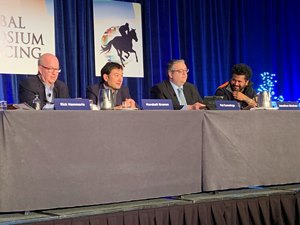Horseplayer Panel Proposes Initiatives at Symposium


As the University of Arizona's Global Symposium on Racing in Tucson, Ariz., marched toward its conclusion late in the afternoon Dec. 11, Rick Hammerle, racing coordinator at Oaklawn Park, remarked that the placement of the "Listening to the Racing Customer" panel so late in the convention seemed apropos.
"Lots of times, it seems, the horseplayer is at the end of the list of the groups that matter to the racing game," said Hammerle, the panel's moderator. "As we know, it should be a little bit higher. Without the horseplayer, the machine doesn't go."
Still, a good-sized crowd was in attendance for an hour-long session that dived into the interests of bettors and areas in which panelists believe the racing industry can improve to appeal to those who help fund it with their gambling.
Jonathon Kinchen, co-host of the "In The Money Players' Podcast" and a gambler and tournament player, stated that everyone in the racing industry is focused on their part of the pie, while not caring "about making the pie bigger."
In short, the three members of the panel—which also included Pat Cummings, executive director of the Thoroughbred Idea Foundation, and Marshall Gramm, professor and chair of economics at Rhodes College—want to see more of the pie returned to horseplayers.
Gramm said he was reluctant to talk about takeout after discussing it during previous Symposiums. But he said he could not pass on the topic again, dissatisfied with the status quo. Tracks "don't allow for what it could be if you give people a chance to churn their money," he said.
He pointed out handle growth of carryover exotic wagers such as the Pick 5 as evidence that takeout reductions would be embraced by bettors, emphasizing that when carryovers exist in those bets, the seeded money largely offsets the takeout for players. Takeout and host-fee reduction is paramount, he said.
Pat Cummings, whose organization has pushed for free handicapping data, among other initiatives, sees growth in such wagers if tracks apply breakage to fund those bets with seeded money, an idea he said has received a favorable response if laws and regulations can be worked out. Under that proposal, breakage—the rounding down of pari-mutuel payoffs, typically to the dime on the dollar—could be steadily accumulated to feed into an exotics wager.
Business as usual, he said earlier in the seminar, can't continue with other wagering options in the marketplace, including sports.
"Sports betting is fresh bread, horse racing is stale bread, and we're on the same shelf," he said. "Horse racing's stale bread is more expensive, less certain, less transparent than the fresh bread that is cheaper, more open, more available."
Beyond lowering wagering costs, panelists called for providing bettors with more information. Recommendations ranged from tracks having their track superintendents discuss daily maintenance on television feeds to projections on upcoming win odds based on "will pays" from multi-race gimmick wagers that have already closed.
Cummings said it is no excuse for tracks to not have officials explain decisions on television, whether it is a track superintendent or a steward. He called out Kentucky stewards and the Kentucky Horse Racing Commission for having limited explanation and post-race comment regarding their disqualification of Maximum Security in this year's Kentucky Derby Presented by Woodford Reserve (G1) at Churchill Downs.
"Part of the reason they didn't say more is this fear of a lawsuit," Cummings said. "They didn't say much, and there is still a lawsuit. What's the harm in getting out there and being more public?"
Panelists also took on the industry's acceptance of differing run-up distances from track to track, distance to distance, and the absence of timing beyond the leader or winning horse. At most Thoroughbred tracks, timing begins when a horse crosses the first applicable timing beam, irrespective of how far away it is from the starting gate. That length is called the run-up, which at Churchill Downs, as one example, is much longer at six furlongs than at other distances.
Similarly, run-ups can markedly differ in turf races, with panelists mentioning Gulfstream Park's 7 1/2-furlong races as another example, noting the varying placement of the temporary rails used for grass racing.
"I'd eliminate the run-up altogether or figure out a way to accurately reflect our distances," Gramm said. "We have one time for a horse finishing first. We don't time all our participants. Can you imagine watching the Olympics and you just have a time for the winner of the race, and everything else is in beaten strides?"
The discussion ended following questions and comments from the audience, with one individual critical of a lack of results from experimentation in lowering takeout while also noting there are a number of groups wanting their share of the takeout percentage.
Canterbury Park lowered its takeout rates in 2016, but its handle increase was not enough to offset the loss in revenue from its smaller rake. The track raised its takeout back up the following year.
Kinchen answered that it is not enough for a small track to lower takeout and hope to see a sudden surge, competing alongside industry leaders.
"Tell me that NYRA is dropping their takeout, or Stronach, or the Derby, or Keeneland, or Del Mar, and that doesn't move the needle. Then I will take that on the chin," he said. "It's not a one-meet experiment. It's an over-time experiment."
